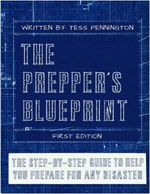This article was originally published by Sara Tipton at Tess Pennington’s ReadyNutrition.com
Tess is the author of The Prepper’s Blueprint: How To Survive ANY Disaster

Those who choose to heat their home with wood are becoming fewer and fewer. However, with more interested in a self-sustaining lifestyle and going off the grid, those numbers may begin to rise again. If you decided to heat your home with wood, there are simply some types of wood that are better to burn in your home.
There is nothing quite like a roaring fire to stand next to while listening to the crackles and pops on a subzero winter day while there’s a raging snowstorm blowing through. If you live in an area where those days are common in the winter, you probably know the benefits of having a wood burning stove firsthand. The heat is immediate and fills the space quickly as opposed to waiting for propane or electric heat to keep up. It’s also oddly comforting.
When talking about burning wood inside for heat, it is important to first talk about the quality of your wood burning stove. Using wood as the main heat source in your home is not for everyone. It’s actually a lifestyle choice. Many summer days will be spent cutting and splitting wood to be used during the winter months and if you choose to buy firewood, the cost may not outweigh the benefits. In my little slice of Wyoming, a cord of wood that is already split and ready to go sell go for as much as $255 per cord for lodgepole pine which is a rather high price compared to many other areas. We use around 5-7 cords per year. The number of cords used will vary based on the quality of your stove, the intensity of the winter, and the size of your home. (We have this wood burning stove and an over 2000 sq foot home.) If you choose to cut your own firewood, that cost will go down to the price of a firewood permit, which is $20 and will allow you to cut 4 cords, the fuel to get the wood home, wear and tear on your equipment, and your labor.
Of course, the main benefit of using a wood burning stove is that it is not dependent at all on electricity. If a winter storm blows through and we are out of power for days on end, we are at the very least, warm and comfortable. There is also the added bonus that you can even use your wood stove to cook a few meals if you have to. It isn’t my favorite way to make a meal because you have to get the stove so hot it’s uncomfortable to do so, but it can be done in pinch!
So what exactly makes some types of firewood better for burning than others? It comes down to two factors: density and water content. The more dense and drier the firewood, the better it will burn and the more heat it can produce in your wood burning stove. Because of this, hardwoods, which tend to be denser, generally make for better firewood than softwoods. Make sure they are dry, however.
1 cord = 200 to 250 gallons of fuel oil (hardwoods) High Heat Value
- American beech
- Apple
- Ironwood
- Red oak
- Shagbark hickory
- Sugar maple
- White ash
- White oak
- Yellow birch
1 cord = 150 to 200 gallons of fuel oil, Medium Heat Value
- American elm
- Black cherry
- Douglas fir
- Red maple
- Silver maple
- Tamarack
- White birch
1 cord = 100 to 150 gallons of fuel oil, Low Heat Value
- Aspen
- Cottonwood
- Hemlock
- Lodgepole pine
- Red alder
- Redwood
- Sitka spruce
- Western red cedar
- White pine
Many of these types of hardwood listed above are not readily available to those living in the pine-dense forested areas of the Rocky Mountains. For that reason, a wood that can be used is Juniper, if you can get your hands on it. It is wonderfully fragrant with a cedar-like aroma. It has medium hardness and mixes well with other woods while burning. Alligator juniper is excellent in the fireplace or in a backyard fire pit and produces a cozy lively fire with crackle, pop, and pleasant aroma. It’s a wood used by many of Arizona’s elite resorts. Utah juniper or cedar is slightly less expensive than alligator juniper and has the same burning qualities. The shaggy bark can provide a nice kindling for your fire and although Utah juniper also has medium hardness, it burns clean and mixes well with any hardwood.
Lodgepole pine is another option as juniper is often difficult to get. This is the wood we choose to use based on our location, efficiency, and how easy it is to find. It has a lower heat value than the hardwoods, but it is readily available. It also has a good straight grain for splitting, it creates a quick hot fire and leaves very little ash. Your selection of firewood should align with the area you live in. There isn’t much sense to made of looking for a sugar maple tree to cut down to heat your home when you live in Wyoming. Therefore, the “best” wood is what you can find, cut, and split easily.
Make sure you “season” or dry your wood before use too. This will help with efficiency too. Wet wood is easier to split than dry wood, however, once split, it should be stacked to dry under cover and out of the rain for six months. If steam bubbles and hisses out of the end grain as the firewood heats up on the fire, the wood is still too wet, or green, and needs to be seasoned longer before burning. Well-seasoned firewood generally has darkened ends with visible cracks or splits. It is relatively lightweight and makes a sharp, distinctive “clink” when two pieces strike each other.
Heating your home with wood in a wood burning stove is about as cozy and comfortable you can get, however, be prepared for hard work to get ready for the winter season.
Tess Pennington is the author of The Prepper’s Blueprint, a comprehensive guide that uses real-life scenarios to help you prepare for any disaster. Because a crisis rarely stops with a triggering event the aftermath can spiral, having the capacity to cripple our normal ways of life. The well-rounded, multi-layered approach outlined in the Blueprint helps you make sense of a wide array of preparedness concepts through easily digestible action items and supply lists.
Tess is also the author of the highly rated Prepper’s Cookbook, which helps you to create a plan for stocking, organizing and maintaining a proper emergency food supply and includes over 300 recipes for nutritious, delicious, life-saving meals.
Visit her website at ReadyNutrition.com for an extensive compilation of free information on preparedness, homesteading, and healthy living.










I don’t see how you heat a 2000 sq ft home in Wyoming on 5-7 cords. Stove must REALLY be efficient.
I have about the same sized home in MO and use 10-12 cord and it is excellent oak and hickory for the most part. It runs about $100-120/ cord here. I cut about 1/3 -1/2 of my own.
For the most part people even in the prepper community don’t realize how much wood it takes to actually heat a home vs just supplementing on cold days and nights.
We heat our 1200 SF home with 2 cords of pine per winter, and most of our winter daytime highs are in the 30s with overnights that easily dip into the negatives. Our woodstove is pretty efficient, but more importantly the house is really well insulated.
I am an architect, with a specialty in energy efficient homes.
YOU ARE CORRECT, but even more important than insulation is air sealing of home
AND direct connect combustion air.
If you do not have direct connect combustion air, your home must draw outside air from everywhere else, and the home MUST then be drafty. and this GREATLY increases the amount of wood per season you need to be comfortable in your home.
so just having direct connect combustion air reduces the heating load. if your stove is snot set up for this feature, it would be a good time to upgrade stoves.
We are about the same as you and have a 4 bedroom house. We use about 3 cords a year. The common wood we use is Juniper/cedar and pinion pine. I love cedar it smells good and splits easy. I usually cut wood from the mountains where it has burned. No bark, no sap, good and hard, no bugs. A good size cedar round will burn virtually all night.
You do know that a face cord and a full cord are two different things, right? 10-12 full cords sounds astronomically high!
I live in Kansas and I love hedge, red elm, and black locust. The hedge burns really hot and some stoves can’t take it but if you can burn it I think it puts out the most heat. Usually burn the American elm in the fall when it isn’t as cold.
You can spray firewood with a solution of borax and water to prevent termites from infesting the wood pile. I keep the wood pile away from the house.
_
“The Illustrated Encyclopedia Of COUNTRY LIVING”
By: Abigail R. Gehring
Illustrations by James Balkovek
Beekeeping-Canning and Preserving-Cheese Making-Disaster Preparedness-Fermenting-Growing Vegtables-Keeping Chicken’s-Raising Livestock-Soap Making
Barns & Noble b&n
ISBN-10: 1-61608-467-7 ISBN-13: 978-1-61608-467-7
$27.00
I just bought this book and it’s a very nice addition to my library.
With so many pictures, it can be used to indoctrinate children with a different message; one of joy in nature and self sufficiency. Pretty handy quick reference book to read in front of the fireplace or near a wood burning stove if you happen to have them.
_
That is a thick book. I look at it as more than just light reading. It does have many good ideas and pointers.
I spend 20+ years in WA state heating with wood.
I violated about every rule in the book.
I used the crappiest green wood, I went through about
3-4 cords per year.
I used non-EPA approved stoves.
I used wood heat when there were air quality burn bans,
issued by city people to us country folk.
My point is to get a good wood stove and feed it with outside air.
Clean your chimney.
Replace your fire brick when it needs it.
Ignore the EPA a$$holes.
I’m surprised the EPA Swat team didn’t raid your house
Wood and coal hot air furnace tied into the oil furnace ductwork. Two tons of coal and three cords of wood will easily heat through a year of normal weather.
I may use 100 gallons of fuel oil in a year…used when it’s not really cold enough to build fire and again when it gets windy and below zero to supplement the wood/coal.
My favorite is locust wood for BTUs. Any flavor, but honey locust is more prevalent here. There is also a lot of Ash killed by the Ash borer beetle. Sad.
I am using the same furnace that was here 30 years ago when I bought the place. I had to tear off the one side of the furnace and weld up the fire box a few years ago. rellik is right…you should replace bad firebrick. I didn’t, and still haven’t, but I’ll probably be dead before it needs welded again.
A good idea is to line your chimney with stainless steel liner. I built many a chimney in my masonry career and this will save your chimney and maybe your life. Every chimney fire you have cracks the clay liners and eventually it will crack through the masonry and catch your house on fire. With stainless you can stop worrying about fires, especially if you have a steel roof too.
I certainly don’t want TSTHTF before I pass because I couldn’t heat with wood without my chainsaw and gas splitter. I have mauls and axes and even a two man saw but I don’t want to HAVE to use them.
Locust? How could you miss that? Harder than oak.
One thing that will save a lot of wood is not heating the house at night. When I was growing up, the heater was off at night. Then we lit the fire again in the morning.
I don’t pay a lot of attention to what I read or hear about wood as far as burning. I got a whole bunch of poplar last year for free and the people I got it from were busy apologizing for it. They read on the internet that it wasn’t very productive as far as btu’s. I burn a lot of wood in my 30×48 ft. shop with no insulation and it burns through the night when banked down a bit. In other words a good bed of coals in the am. What more can you ask for. We have a lot of Doug fir and alder as well as maple on our place. All are excellent wood when cured a bit. We don’t rape our place but fall dead standing firs and cull out the occaisonal alder and maple. Burn what ya got. Yes, we are set up for wood cutting and we get some permits from the forestry. Wood gets you warm twice. Once when you cut and split it and once when you burn it. If you don’t have a peavy you don’t cut much wood. Why didn’t peavy pass spell check?
2008 my home was hit by lighting and burned . I was left with the outside shell and no roof . I gutted and reinsulated the home myself . 6 in walls and extra insulation in the ceiling . I removed the fireplace ,put in a steel liner and a stove insert . I have two Farm Boss saws and a Fitch electric splitter . I burn oak . I just replaced my geothermal forced air system with a 96% Amna gas furnace and 16 seer condenser. I love a wood fire and have one going most of the winter in Mn. Woods not hard to find and move it with an F350 and tandem axel trailer . A little work is good for Ya.
Hedge burns the hottest, hands down. In fact it will burn your flew down if not careful.
Two tips.
Some areas have ordinances that you can’t cut down a living tree without a permit. So one nearby farmer plants a double row of elm on either side of his farms roadways. The trees get to be about ten years old and Dutch Elm disease kills them. Cuts the dead ones up for firewood and plants replacements.
When stacking firewood always stack it with the bark side up, it sheds rainwater, stays drier and seasons faster.
You want hot? Manzanita baby!